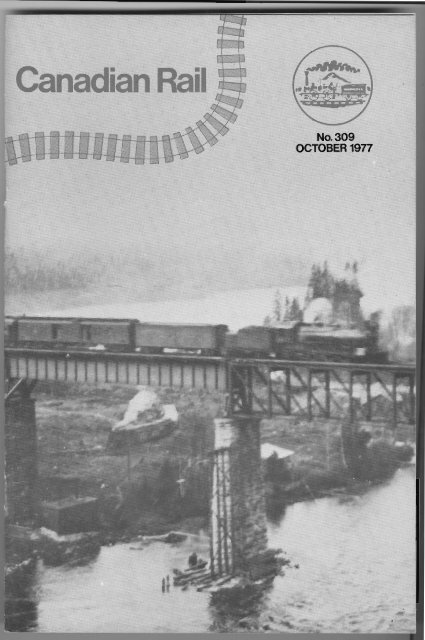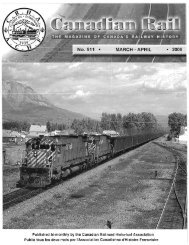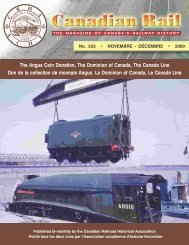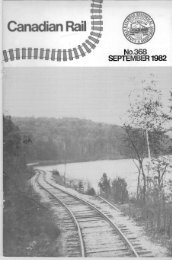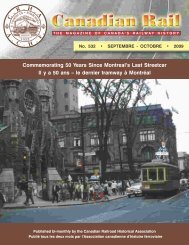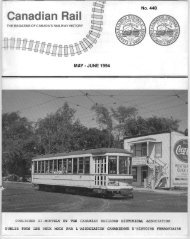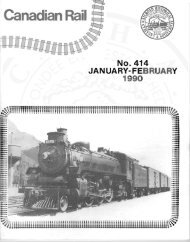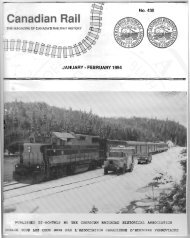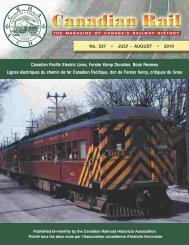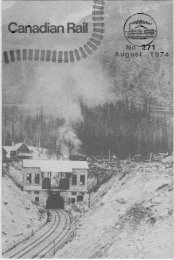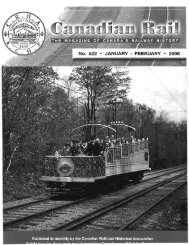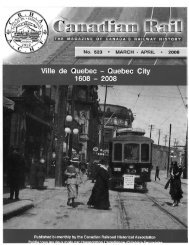Canadian Rail_no309_1977
Canadian Rail_no309_1977
Canadian Rail_no309_1977
Create successful ePaper yourself
Turn your PDF publications into a flip-book with our unique Google optimized e-Paper software.
<strong>Canadian</strong> <strong>Rail</strong><br />
No. 309<br />
OCTOBER <strong>1977</strong>
IAN<br />
ISSN 0008 - 4875<br />
COVER PHOTO:<br />
Although the odds were greatly<br />
against it happening, Mr. T.S .<br />
Armstrong of Thunder Bay,<br />
Ontario was most fortunate to<br />
catch both the CPR passenger<br />
train high on the Nipigon Bridge<br />
while under chuffed the 'NIPIGON<br />
TRAMWAY' along the river bank .<br />
While the date of the photo is<br />
unknown it was probably taken<br />
around 1910.<br />
OPPOS I TE :<br />
This rare photo taken by Mr. A.<br />
J . Isbester, chief engineer for<br />
the <strong>Canadian</strong> Northern Ontario<br />
<strong>Rail</strong>way, shows the freighting<br />
operation as carried out up the<br />
Nipigon River. The steam driven<br />
tug 'NIPIGON' is hauling the<br />
barge loaded with narrow gauge<br />
flat cars, they in turn are<br />
loaded with construction materials<br />
for the building of the<br />
CNOR.<br />
Published monthly by The <strong>Canadian</strong><br />
<strong>Rail</strong>road Historical Association<br />
P.O. Box 22, Station B<br />
Montreal Quebec Canada H3B 3J5<br />
EDITOR: M. Peter Murphy<br />
EDITOR EMERITUS : S. S. Worthen<br />
BUSINESS CAR: John Welsh<br />
LAYOUT : Joe Smith<br />
CALGARY & SOUTH WESTERN<br />
L. M. Unwin, Secretary<br />
1727 23rd Ave. N.W., Calgary Alberta<br />
T2M lV6<br />
OTTAWA<br />
D. E. Stoltz, Secretary<br />
P. O. Box 141, Station A, Ottawa,<br />
Ontario K1N 8Vl<br />
PACIFIC COAST<br />
R. Keillor, Secretary<br />
P. O. Box 1006, Station A, Vancouver<br />
British Columbia V6C 2Pl<br />
ROCKY MOUNTAIN<br />
C. K. Hatcher, Secretary<br />
P. O. Box 6102, Station C, Edmonton<br />
Al berta T5B 2NO<br />
TORONTO & YORK DIVISION<br />
J. C. Kyle, Secretary<br />
P. O. Box 5849, Terminal A, Toronto<br />
Ontario M5W lP3<br />
WINDSOR-ESSEX DIVISION<br />
R. Ballard, Sr., Secretary<br />
300 Cabana Road East, Windsor,<br />
Onta ri 0 N9G 1 A2
The<br />
pigon<br />
Tromway.hO Todd<br />
The #<strong>Canadian</strong> Northe1"l'f Station and<br />
water tan ... t Nipigon, Ontario<br />
T.s.Armstrong photo. ..~~~~
If you pick up a modern map Provincial Park, then Lake Nipigon,<br />
follow~d by the Nipigon<br />
of the still remote terr1tory<br />
north of the most northerly portion<br />
of Lake Superior ,in eastern the town of Nipigon, located on<br />
River and, last but not ~ east,<br />
Canada, you will find several a she~tered bay on the north<br />
geographical tures all having shore ~f Lake Superior at the<br />
the same na There is Nipigon' mouth of the Nipigon River, mile<br />
63.3 on the N~pigo~ SID of CP<br />
RAIL. The town of Nipigon has a<br />
very important claim to fame in<br />
<strong>Canadian</strong> histor it played an<br />
important role n t buildjng<br />
.l.....A.IH' all th·ree<br />
ans-
CANADIAN 298 R A I L<br />
cal inducements and personal vanity to consider most seriously<br />
a second transcontinental railway, to run north of the <strong>Canadian</strong><br />
Pacific from Quebec to a port on the Strait of Georgia north of<br />
Vancouver. The new railway would also act as a development line,<br />
opening up vast areas to settlement, thus assuring Sir Wilfred<br />
of a permanent place in the history of the development of our<br />
country.<br />
While the concept may have been valid, it took lengthy<br />
negotiations and a few years before an agreement was reached with<br />
the then powerful Grand Trunk <strong>Rail</strong>way Company of Canada, which had<br />
been selected to operate the new railway. It was finally agreed<br />
that the Government of Canada would build the eastern section of<br />
the National Transcontinental <strong>Rail</strong>way, from Moncton, New Brunswick,<br />
via Quebec to Winnipeg, a little more than 1,800 miles. The Government<br />
would, upon its completion, lease the line to the Grand Trunk<br />
Pacific <strong>Rail</strong>way for 50 years at an annual rental of 3% on the cost<br />
of construction. This turned out to be a bad bargain for the<br />
parent company, the GTR.<br />
The western portion, from Winnipeg to Prince Rupert, on<br />
an inlet off Chatham Sound, was to be constructed by the Grand<br />
Trunk Ra\lway Company and. was to be completed by December 1, 1908.<br />
Entitled I Dr. Herman Bryan M.D. en route to <strong>Canadian</strong> National <strong>Rail</strong>way<br />
construction, north of Ombabika Bay on Lake Nipigon I, and taken by<br />
E.C.Everett, Commercial Photographer, Nipigon, Ontario. Our readers<br />
will probably be more interested in the 0-4-0 tank engine and the<br />
flat cor in the background than in the good Doctor. Fortunately for<br />
us the photo was taken and discovered in time for presentation with<br />
this article.
.. , . .<br />
The transportation of rails for the construction of the National<br />
Transcontinental <strong>Rail</strong>way in 1908 on Lake Nipigon, this time without<br />
the narrow gauge flat cars.<br />
Marion Steam Shovel' model 60 ' as used by E.F. and G.E. Faquier contractors<br />
on the construction of the National Transcontinental <strong>Rail</strong>way<br />
in the Nipigon region. T.S.Armstrong photo.
These three photos all taken by Mr.T.S.Armstrong give an excellent<br />
indication of life as it was in the early 1900' s in the Nipigon<br />
Region or Northern Ontario. In the first photo we see the S.S.<br />
OMBABIKA docked on the shore of Lake Nipigon. Secondly a group<br />
of Native People in their Birch Bark Canoes as photographed from<br />
the S.S. WABINOSH. Thirdly an across the lake view of the S.S.<br />
WABINOSH CACHE docked at the same location as seen in photo one.<br />
It was to be built to standards equivalent to the GTR main line<br />
between Montreal and Toronto. The <strong>Canadian</strong> Government would<br />
guarantee cost of construction and interest to a maximum of 75%<br />
of the construction bonds issued by the GTP, such bonds to be<br />
limited to $13,000 per mile on the prairies and $30,000 per mile<br />
on the mountain section.<br />
Government survey crews for the National Transcontinental<br />
project passed through Nipigon in the autumn of 1903. From<br />
there, they went by boat to the north end of Lake Nipigon, where<br />
they began running trial locations for the railway. The route<br />
finally selected was similar to that recommended by Sanford<br />
Fleming for the Pacific <strong>Rail</strong>way nearly 35 years before.<br />
An engineering headquarters was built at Nipigon in 1904
The EngiFleers office for the' Trans Con-tinental <strong>Rail</strong>wcry' located in<br />
Nipigon, Ontario. Photo courtesy Mr. T.S.Armstrong of Thunder Bay.<br />
to service Division E civil engineers of the National Transcontinental<br />
<strong>Rail</strong>way, which ran easterly from English River nearly to today's<br />
town of Hearst. Mr. T.S. Armstrong was the chief engineer.<br />
Messrs. O'Brien, Fowler and Macdougall Limited were<br />
awarded two contracts, amounting to 150 miles of railway, immediately<br />
to the east of the point where the GTP branch to Fort<br />
William left the main line. This point had been named Superior<br />
Junction, for obvious reasons. E.F. and G.E. Faquier Limited were<br />
also awarded two contracts, one for the 75-mile section eastward<br />
from Lake Nipigon to Grant and the other 100 miles westward from<br />
Abitibi Crossing, the crossing of the Abitibi River in remote<br />
northeastern Ontario.<br />
Transporting equipment and supplies into this remote region<br />
north of Lake Nipigon posed a big problem for the contractors.<br />
Winter totp-roads were built from various locations on the <strong>Canadian</strong><br />
Pacific Rai Iway. Teams of horses hauled in supplies to the construction<br />
sites, usually about 100 miles to the north. Dog-teams<br />
also proved to be useful. In summer, the Nipigon water route provided<br />
the best means of transport. The problem of portaging the<br />
many rapids on the upper Nipigon River was resolved by building<br />
an 18-mile three-foot-gauge tramway. Its construction and operation<br />
was undertaken by the Nipigon Construction Company and it was<br />
called the Nipigon Tramway.<br />
At Nipigon on Lake Superior, a large wharf and warehouse<br />
were built underneath and upstream from the <strong>Canadian</strong> Pacific's high<br />
bridge over the river. All the supplies for the construction camps<br />
were loaded onto the narrow-gauge flat cars, which, in turn, were<br />
loaded onto a scow or primitive car-ferry for the three-hour trip<br />
up Lake Helen and the Nipigon River to Alexander Landing (or Alex-
(<br />
Three photos showing the evolution of the Nipigon River Bridge of the<br />
<strong>Canadian</strong> Northern <strong>Rail</strong>road. The first picture was taken by Mr. A.J.<br />
Isbester chief engineer and shows the falsework behind which is the<br />
tug 'NIPIGON'. Next a broadside view of the falsework, and finally<br />
the completed steel bridge over the river.
CANADIAN 303 R A I L<br />
ander Point), a distance of 12 miles. The loaded cars were here<br />
run off the scow to the "main line" of the narrow-gauge, and hauled<br />
18 miles by a diminutive "donkey engine" (0-4-0 saddle-tank) to<br />
South Bay at the south end of Lake Nipigon.<br />
The loaded cars were stored here in warehouses, until the<br />
second part of the trip was begun. The cars were loaded again onto<br />
the primitive car-ferries for the 70-mile trip to the northern depot<br />
on Ombabika Bay. The cars were rolled off the scows to the second<br />
part of the "main line" and hauled two miles further north to<br />
the construction site, now the town of Ferland on the <strong>Canadian</strong><br />
National <strong>Rail</strong>ways' Caramat 5/0.<br />
Two steam tugs were used to push the scows up the lake;<br />
they were the "Ombabika" and the "Pewabic", both built as lake<br />
fishing boats about 1901. The steam tug "Nipigon" was used to push<br />
the scows on the Lake Helen-Nipigon River run and a small tug alongside<br />
the scow helped to guide it through the fast-flowing, turbulent<br />
waters.<br />
The return trip from Ombabika Day, with empty cars on the<br />
car-float, was made at a much faster speed. On arrival at the<br />
southern terminal, the cars were hauled off the scow by horse power<br />
and take,lb __ to th.e, .. wareh.o,lJses, where theYo.were ·r,e·loadedas quio-kly as<br />
possible for another trip up the lake. Hay and oats for the horses,<br />
coal for the steam engines, track-building material, commissary's<br />
supplies and other associated items were rushed up the lake before<br />
the freeze-up in the fall of 1908 0<br />
The <strong>Canadian</strong> Pacific built a siding, or, more correctly,<br />
a spur from its main line to the warehouses alongside the narrowgauge<br />
railway, where construction materials and supplies were interchanged.<br />
<strong>Rail</strong>s for the National Transcontinental were also unloaded<br />
here for transhipment onto the narrow-gauge cars. In 1908,<br />
a large dredge was busily engaged in deepening the channel into<br />
Nipigon Bay, so that the larger lake freighters, laden with rails,<br />
could tie up alongside the wharf.<br />
At each rail-water interface point on the narrow-gauge,<br />
loading ramps, each with three tracks, were built so that the loaded<br />
or empty cars could be run on and off the scows. Each of the<br />
three tracks on the scows held three cars, for a total of nine cars<br />
per scow.<br />
Passengers were also transported on the tug-boats. For<br />
the rail portion of each journey, passengers enjoyed the rocky<br />
ride over the portage railway in a closed-in car with longitudinal<br />
benches, the capacity of the vehicle not being known.<br />
An alternate route to the construction site, via Windigo<br />
Bay on the northwest side of Lake Nipigon, involved traversing a<br />
formidably rough terrain and only light supplies were brought in<br />
to the NTR location over this route. "Ombabika" in the Ogibway<br />
language means "a high rock cliff rising up from the edge of the<br />
river".<br />
When the winter freeze-up arrived, the tote-road from<br />
Nipigon again was used to transport the essential supplies north<br />
to the construction sites.
Construction scenes along the <strong>Canadian</strong> Northern <strong>Rail</strong>way include this<br />
un-identified 4-6-0 with gantry on the Blende River Bridge follawing<br />
its completion. No. 1240 got her feet wet following a wreck at the<br />
Current River Yard,
Animal power pulling narrow gauge lorries was the order of the day<br />
as workmen dug through this clay cut at mile 86, the lorries were<br />
transferred to locations requiring fill as noted in the second photo.<br />
View of yet another extensive cut under construction near the town<br />
of Nipigon.
Pilings for the trestle over the Kenogami River at Long Lac, Ontario,<br />
the trestle was built on a 4 degree curve and required 61 'bents'.
CANADIAN 309 R A I L<br />
In 1908, at Nipigon, two, old, rival fur-trading companies,<br />
the Hudson's Bay Company and Revillion Fr~res, were located<br />
side by side. Both firms were still engaging in competition<br />
for the furs of the local Indians and trappers. A little further<br />
up the town's main street there was a store operated by William<br />
McKirdy, an old Hudson's Bay man, who competed successfully for<br />
local furs with his two powerful rivals.<br />
Wholesale businesses established branches in Nipigon to<br />
supply contractors with groceries and hardware. A branch of the<br />
Bank of Ottawa was soon opened to transact the business offered<br />
by the contractors, among whom were Messrs. Chambers, McQuaig,<br />
McCaffrey and Russell. This company later built the rock breakwaters<br />
in the harbour at Port Arthur.<br />
Many other business establishments were soon opened in<br />
the town, including hotels, restaurants, stores and a barber shop.<br />
All of them, including the last one named, did a thriving business.<br />
No sooner had construction on the National Transcontinental<br />
begun than William Mackenzie and Donald Mann, owners of the<br />
<strong>Canadian</strong> Northern <strong>Rail</strong>way, announced plans to build a Pacific and<br />
an eastern extension to their system, which would thereby create<br />
yet a third Trans-Canada railway. Un December 30, 1902, the railway<br />
from Winnipeg to Fort William had been completed and it now<br />
remained to build a main line from the Lakehead to Toronto and<br />
Montr~al. Survey crews began running trial locations east from<br />
Fort William-Port Arthur in 1905. By September 1910, the route<br />
of the Port Arthur-Ottawa railway was announced and the <strong>Canadian</strong><br />
Northern (Ontario) <strong>Rail</strong>way Company was incorporated to build it.<br />
Contracts for the new railway were awarded to Foley<br />
Brothers, Welch and Stewart and construction started in the spring<br />
of 1911. Rapid progress was made, steel laying being started at<br />
Port Arthur in June 1912. By March 1913, the new railway was completed<br />
for 130 miles eastward to a point 70 miles west of Sudbury<br />
(Capreol). On January 1, 1914, Sir William Mackenzie drove the<br />
last spike in this section at Little White Otter River, 254 miles<br />
east of Port Arthur. Ballasting was still incomplete and it was<br />
October before a freight service was started between Toronto and<br />
Port Arthur.<br />
The location chosen followed Nipigon Bay from a point<br />
just north of Red Rock to the town of Nipigon. Here, the <strong>Canadian</strong><br />
Pacific right-of-way hugged the shoreline at the base of a high,<br />
focky bluff and there was just no room for another right-of-way.<br />
To overcome this obstacle, the <strong>Canadian</strong> Northern built a ret.ining<br />
wall close to the Lake's shoreline and filled the space between<br />
it and the rocky shore with a huge amount of rock and fill, dredged<br />
from the lake and brought in from other locations. At Nipigon,<br />
the new line crossed a lagoon on a causeway, which also required<br />
a very large amount of fill.<br />
After passing under the <strong>Canadian</strong> Pacific's Nipigon River<br />
bridge, the <strong>Canadian</strong> Northern turned north, staying on the west<br />
bank of the Nipigon River for six miles and then crossing the river<br />
on a multi-span bridge. After running a further four miles on the<br />
river's east bank, the line turned northeast along the shore of<br />
Orient Bay, a long, narrow inlet on the southeast end of the main<br />
lake. Leaving the lake, the line headed for Long Lac, 198 miles to
CANAD IA N 310 R A I L<br />
the east and only 32 miles south of the National Transcontinental's<br />
main line at Nakina.<br />
During the building of the <strong>Canadian</strong> Northern, headquarters<br />
were established at Nipigon by the surveyors; Foley Brothers,<br />
Welch and Stewart also had their headquarters there. The Nipigon<br />
River route and the narrow-gauge tramway were again used to transport<br />
equipment and supplies to the construction sites along the<br />
Nipigon River and Orient Bay. As a consequence, the town of<br />
Nipigon continued to prosper during this second period of railway<br />
buil di ng.<br />
With the completion of the <strong>Canadian</strong> Northern <strong>Rail</strong>way's<br />
line through northern Ontar i o early in 1914, with the subsequent<br />
introduction of freight service in October 1914 and passenger service<br />
in 1915, the last of Canada's transcontinental railways was<br />
completed. Today, Nipigo n , Ontario, is not as prosperous as it<br />
once was, but it remains as a fine example of the many scenic locations<br />
in this region of northern Ontario.<br />
Additional Notes<br />
Today, there are three large hydroelectric power plants<br />
on the upper Nipigon River, between Nipigon and South Bay. These<br />
are at Pine Portage, Ca meron Falls and Alexander. The latter two<br />
are close together, while the former is up-river and was the last<br />
one built.<br />
Armstrong, Ontario, the western terminus of <strong>Canadian</strong><br />
National <strong>Rail</strong>ways' Caramat 5/0, is named for T.S. Armstrong, Chief<br />
Engineer on Division E of the National Transcontinental <strong>Rail</strong>way.<br />
The late Duke of Windsor was taken on a fishing trip on<br />
Th e motor launch as us e d by Foley Brothers during construction of<br />
th e railway.
Even after completion of the grade workmen had to often return to<br />
repair flood damage to newly placed fill. Firstly a slide at Red<br />
Rock being repaired by a clam shovel aboard a barge, then two phatos<br />
of serious washouts along the line. All photos in this series courtesy<br />
of the author's collection.
CANADIAN 312 R A I L<br />
Lake Nipigon and the upper Nipigon River during his tour of Canada<br />
in the summer of 1924. Mr. John G. McKirdy, now of Thunder Bay,<br />
was a guide with the party.<br />
The region encompassing Nipigon Provincial Forest and<br />
Nipigon-Onaman Game Preserve is a paradise for the nature-lover<br />
and sportsman, well known for its beautiful scenery, fishing and<br />
hunting. The area is accessible from Ontario Highway 11, the<br />
northern Ontario "Trans-Canada Highway" route.<br />
The National Transcontinental <strong>Rail</strong>way's Division E Engineering<br />
Headquarters building of 1904 was used by the surveyors of<br />
the <strong>Canadian</strong> Northern <strong>Rail</strong>way during its construction in 1911. The<br />
Nipigon Woodlands Division of the Brompton Pulp and Paper Company<br />
of East Angus, Quebec, used this building as its main office for<br />
many years. DOMTAR, the successor to Brompton Pulp and Paper, sold<br />
the building and land to the town of Nipigon for the sum of $1 and<br />
other considerations, with the provision that is should be used and<br />
maintained as a museum for the collection and preservation of items<br />
associated with the history of the Nipigon area.<br />
REFERENCES<br />
"Trains of Recollection":<br />
"<strong>Canadian</strong> National <strong>Rail</strong>ways,<br />
Volume 2: Towards the<br />
Inevitable":<br />
"Canada Great Highway: From<br />
the First Stake to the Last<br />
Spike":<br />
"Port Arthur NEWS":<br />
"Fort William TIMES<br />
JOURNAL":<br />
Hanna, D.B. The Macmillan<br />
Company of Canada, Toronto<br />
1924.<br />
G.R. Stevens; Clarke, Irwin<br />
& Company, Toronto 1962.<br />
Secretary, J.H.E., London,<br />
Engl and 1924.<br />
Thunder Bay. Ontario, October<br />
12, 1908.<br />
Thunder Bay, Ontario. October<br />
31,1908.<br />
ACKNOWLEDGEMENTS<br />
The author would like to thank the following people for<br />
their valuable assistance in the preparation of this article:<br />
Mrs. J. Si mpson<br />
Mr. T.C. Armstrong<br />
Mr. Cl ifford Brown<br />
Mr. E.C. Everett, Photographer<br />
Mr. William Germaniuk<br />
Mr. John G. McKirdy<br />
Mr. L.M. "Buzz" Lein<br />
Mr. H.J. Netemegesic<br />
Mr. W.H. Thompson<br />
Mr. J. Thorsteinson<br />
The Nipigon Museum<br />
The Nipigon GAZETTE<br />
Mr.James Dawson<br />
Thunder Bay, Ontario<br />
Thunder Bay, Ontario<br />
Thunder Bay, Ontario<br />
Nipigon, Ontario<br />
Thunder Bay, Ontario<br />
Thunder Bay, Ontario<br />
Midland, Ontario<br />
Nipigon, Ontario<br />
Nipigon. Ontario<br />
Beardmore, Ontario<br />
Nipigon, Ontario<br />
Nipigon, Ontario<br />
Thunder Bay, Ontario.
The '.<br />
. '~'<br />
business car<br />
BRITISH COLUMBIA RAILWAY'S RAILWEST CAR MANUFACTURING PLANT AT<br />
Squamish has -c-losed. Tile plant opened March 27,19'%,<br />
and had a ~/Ork force of 260 at peak. A total of 1,400<br />
cars came off its assembly line. Decision to tlose down followed<br />
unsuccessful .attempts to gain additional contracts.<br />
(Toronto GLOBE AND MAIL)<br />
SIX MAJOR RAILWAYS HAD A COMBINED OPERATING PROFIT OF $28.8 MILlion<br />
on their <strong>Canadian</strong> operations in June <strong>1977</strong>, up from<br />
$4.2 million in June 1976, according to Statistics<br />
Canada. Operating revenues rose 14.5 percent to $296 million<br />
while operating costs rose 5.1 percent to $267.2 million a year<br />
earl ier.<br />
For the first six months of <strong>1977</strong>, operating profit<br />
totalled $113.7 million, up from $20.7 million a year earlier.<br />
Operating revenue totalled $1.68 billion, up 13 percent, and<br />
operating expenses totalled $1.57 billion, up 6.8 percent.<br />
The six lines are CN, CP <strong>Rail</strong>, QNS & L, B.C. <strong>Rail</strong>way,<br />
Ontario Northland and Chesapeake & Ohio.<br />
(Toronto GLOBE AND<br />
MAIL)<br />
CN IS TESTING COMPOSITE BRAKE SHOES IN AN ATTEMPT TO I(EDUCE THE<br />
number of forest fires caused by brake sparking, according<br />
to a Halifax news report of August 20, <strong>1977</strong>.<br />
Statistics from tile Nova Scotia lands and forests department<br />
say eight to ten percent of all forest fires in the province<br />
are caused by trains. Last year, 43 fires attributed to<br />
trains destroyed 244 acres of woodland. After every railwaycaused<br />
fire the railway is billed for the cost of extinquishing<br />
it, says a provincial official.
CANADIAN 314 R A I L<br />
Davis Blair, CN's Atlantic Region vice-president, says<br />
composite shoes are being investigated for rate of wear, minimum<br />
sparking, ease of installation and cost per unit.<br />
WHITE RIVER JUNCTION'S OLD ROUND HOUSE IS TO BE USED BY UNITED<br />
<strong>Rail</strong>way Supply Co. of Montreal as a diesel locomotive<br />
engine rebuilding plant. URS will lease the building.<br />
from the Central Vermont <strong>Rail</strong>road and hopes to open another fac,lity<br />
in St. Albans, Vt. if a suitable building can be made available.<br />
Each operation would employ 35 people at peak.<br />
(The "470", Portland)<br />
SIR SANDFORD FLEMING (1827-1915) RECEIVES RECOGWITION WITH A NEW<br />
<strong>Canadian</strong> twelve-cent stamp, issued September 16, <strong>1977</strong>,<br />
and featuring a train crOSSing one of the Flemingdesigned<br />
steel bridges on the Intercolonial <strong>Rail</strong>way.<br />
Fleming designed Canada's first stamp, the Three Penny<br />
Beaver. In addition to surveying a route for the ICR, he worked<br />
on the CPR, invented a system of standard time and promoted the<br />
Pacific cable.<br />
RAIL PASSENGER TRAFFIC IS MAKING A STRONG COMEBACK THIS YEAR, ACcording<br />
to rail officials quoted in the Toronto "Globe<br />
and Mail" (August 31, <strong>1977</strong>). Passenger traffic is up<br />
about 10 percent so far this year. On the Toronto-Montreal route<br />
the increase is 20 percent. August saw a "phenomenal" 30 percent<br />
increase, mainly because of the air traffic controllers' strike<br />
as well as flight delays that followed the controllers return to<br />
work. CN's Montreal-Toronto Turbo and Rapido services have carried<br />
about 70,000 more passengers so far this year than last,<br />
according to Harold Murray, CN general manager, passenger services.<br />
"Even our transcontinental traffic is 7 percent ahead of<br />
last year. Toronto-Ottawa is up about 10 percent, while passenger<br />
traffic in southwestern Ontario (Toronto-London-Windsor-Sarnia)<br />
just continues to grow and is up by 11 percent", Mr. Murray said.<br />
In the Maritimes, CN passenger traffic is up by 6 percent. Holiday<br />
tours by train introduced by CN are also proving very popular;<br />
between Montreal and Toronto, between Winnipeg and Churchill<br />
and from Toronto and Montreal for boat tours of the Thousand Islands<br />
- "we are gOing to carry 17,000 to 18,000 people to the<br />
Thousand Islands this year".<br />
LAKE MICHIGAN TRAIN FERRIES ARE STILL OPERATING BUT BOTH GRAND<br />
Trunk Western and Chessie System are trying to get out<br />
of the business because of the losses incurred. GTW<br />
petitioned the ICC for permission to abandon the operation more<br />
than two years ago, the Chessie System some three years ago.<br />
Chessie carries both passengers and automobiles; GTW has not<br />
been permitted to carry autos and dropped passenger service in<br />
1971.<br />
(The "470", Portland)
CANADIAN 315 R A I L<br />
TRAINS OF NORTHERN NEW ENGLAND IS A NEW ILLUSTRATED BOOK BY JOHN<br />
Krause and Frederick Bailey, which covers Rutland, B&M,<br />
Maine Central and Central Vermont. Publisher is Quadrant<br />
Press, 19 West 44th. St., New York, N.Y. 10036 and the<br />
price is $7.50 plus $0.50 for postage, according to a brief review<br />
in the <strong>Rail</strong>road Enthusiasts' Portland Division newsletter of<br />
August <strong>1977</strong>.<br />
THE MARY MARCH MUSEUM IN GRAND FALLS' NEWFOUNDLAND HAS LITERALLY<br />
dug up an addition to its collection - a century old locomotive<br />
that has been buried underground since the late 1930' s.<br />
Museum curator Glen Stroud says the locomotive, the first steam<br />
engine used on Newfoundland rails, is in poor condition but can<br />
be restored so that its exterior will be a replica of the origionol.<br />
Stroud said it is not likley the 20 foot -<br />
back to working condition.<br />
long engine can be brought<br />
The museum is attempting to find out some of the details of the<br />
locomotiv~, which was brought to Newfoundland in 1881 from the Hawthorn-Leslie<br />
works in England.<br />
It once operated as engine No.1 on the Harbour Grace - St.John's<br />
run but later spent many years running between Grand Falls, an<br />
inland newsprint town, and the seaport of Botwood. In the late<br />
1930' s it was stripped and buried behind the newsprint mill here.<br />
"It's behind the mill above ground right now," said Stroud, "and<br />
once we have a place to put it and have some research done, we<br />
hope we can get some people to volunteer time and knowledge to<br />
restore it."<br />
(The Montreal Gazette)<br />
CN's GIMLI (MAN.) TRANSPORTATION TRAINING CENTRE MARKED FIVE YEARS<br />
of operation June 5/77. The centre, which began with a<br />
class of 20 students, has provided training for 4,394 CN<br />
transporta ti on employees from all pa rts ot Canada. Of these, 1,450<br />
were student locomotive engineers. The school now includes courses<br />
for train dispatchers, transportation supervisors, master mechanics,<br />
general yardmasters and operational trainees. In addition to CN<br />
personnel, Giml i has accepted students from the Ontario Northl and,<br />
British Columbia, Central Vermont and Duluth, Winnipeg and Pacific<br />
railways.<br />
-- CI~ "KEEPING TRACK"<br />
RECOMMENDED READING FOR TRACTION/TRAM/INTERURBAN ENTHUSIASTS IS<br />
"Headlights" (Electric <strong>Rail</strong>roaders Association Inc.) for<br />
July-December/76 (Vol. 38, No. 7-12) offering 48 pages<br />
on operations in Europe with more than 100 fine photos, detailed<br />
captions, useful notes for the visitor, indices of traction in, a)<br />
Western Europe, b) Eastern Europe and of interurban services all<br />
over Europe etc. Responsible for this issue was John F. Bromley<br />
of Etobicoke, Onto
Richard L. Shantler of our Vancouver Branch has been kind enough<br />
to forward two recent photos showing the arrival of the new 'light<br />
rail transit cars' for Edmonton at the Vancouver docks. The car<br />
bodies were loaded onto CP rail flat cars for the eastward journey<br />
to Edmonton from Vancouver.
Gord Taylor from Lakeside, Ontario has sent along two interesting<br />
photos showing the view from within and without Norfolk and Western<br />
F unit 3725 as she operates over trackage in Southern Ontario.<br />
3725 is <strong>Canadian</strong> built and the last 'F' unit in operation on the<br />
N & W. The cab view shows the scene as the 3725 enters St.<br />
Thomas, Ontario yard on joint CN - NW trackage. Just ahead is<br />
the former London & Port Stanley level crossing which intersects<br />
at the signal. Our thanks to Gord for submitting these two<br />
photos.
CANADIAN 318 R A I L<br />
AMTRAK UPS FARES, CUTS TRAINS - EFFECTIVE OCTOBER 30, <strong>1977</strong> SERVICE<br />
in Amtrak's Northeast Corridor and on three other routes<br />
will be cut back and fares on most routes will increase<br />
about 2t percent to help trim a deficit projected at $535 million<br />
for fiscal 1978 which begins October 1. <strong>1977</strong>. In the Boston<br />
Washington corridor, an average 22 trains daily out of 120 being<br />
operated will be trimmed. largely involving weekends and shorter<br />
runs. 10 Metroliner runs are to be dropped. Daily service will<br />
be cut to four times a week on the Washington-Cincinnati "Shenandoah"<br />
and the Washington-Catlettsburg, Ky. "Hilltopper". One<br />
daily round trip and one Sunday-only round trip of Chicago-Milwaukee<br />
Turboliner service will be eliminated. Public hearings will<br />
be held on possible elimination or service reductions for the<br />
Chicago-Florida "Floridian".<br />
Effective September 8. the New York-St. Petersburg<br />
"Champion" was discontinued; the "Empire Builder" was cut to<br />
four times a week and the "~orth Coast Hiawatha" to three times<br />
a week. Also cut to four times a week were the "San Joaquin"<br />
and the "Palmetto"; to three times a week the St. Louis-Laredo<br />
portion of the "Inter-American".<br />
Cuts . on other routes are being considered.<br />
("Wall Street Journal")<br />
(Note by Editor: Amtrak announced its October 30th changes a full<br />
two months before the effective date. Can <strong>Canadian</strong>s expect the<br />
same considerate attention from VIA?)<br />
CN HAS BEEN ORDERED BY THE CTC TO CONTINUE PASSENGER TRAIN SERVICE<br />
between Toronto-North Bay-Kapuskasing which includes the<br />
overnight Northland and week-end trains between Toronto<br />
and North Bay. The commission said it will review its findings if<br />
the new service of the Ontario Northland meets the needs of the<br />
public; this "Northlander" service started last June and runs six<br />
days a week. CN operating losses on this route rose to $2.9 million<br />
in 1975 from $1.6 million in 1972. (Toronto GLOBE AND MAIL.<br />
September 10, <strong>1977</strong>)<br />
CP RAIL HAS EMBARKED ON THE FINAL PHASE OF A FIVE-YEAR, SlO-MILlion<br />
upgrading of its Megantic-Saint John. N.B. main<br />
line of some 300 miles. Significant increases in traffic.<br />
particularly container movements from the Port of Saint John.<br />
and longer and heavier trains have made these track improvements<br />
necessary. according to division engineer S.K. Chopra. Saint John.<br />
Over 250.000 new ties and more than 1.5 million tons of ballast<br />
will have been laid on completion in September <strong>1977</strong>. One of the<br />
most difficult pieces of track to rebuild was between Mattawamkeag<br />
and Vanceboro. In some areas more than 1,300 new ties per mile<br />
were required. Work crews have averaged more than one mile of<br />
completed track per day with the program running during the frostfree<br />
months from May to November. In some areas. the line was so<br />
remote a "meals on wheels" scheme was used to get food to the men.<br />
This called for a work train or track motor car travelling up to<br />
10 miles from the auxiliary diner to deliver hot meals.<br />
(CP RAIL NEWS)
CANADIAN 319 R A I L<br />
BRITAIN'S fASTEST TRAINS (80 MPll AND OVER) ARE REVIEWED IN THE<br />
"<strong>Rail</strong>way Magazine" of August <strong>1977</strong>. Douglas ferry's<br />
five-page article notes that "Britain's first 100 mph<br />
bookings and no less than 73 runs at more than 90 mph (to be increased<br />
to 81 runs after October) •. keeps this country fl rmly in<br />
the position of second only to Japan". The HST programme helps<br />
to give a total of 303 daily runs at 80 mph and over, covering<br />
21,635 miles between them, in the summer <strong>1977</strong> timetables.<br />
The Great Western Region leads with four runs Swindon<br />
Reading at 103.3 mph (166.3 kph) in a total of 136 runs. West<br />
Coast's best effort is topped by two trains Rugby-Watford at 88.8<br />
mph (143 kph) in a total of 165 runs. East Coast shows only two<br />
runs of which the best is one run York-Darlington at 81.4 mph<br />
(.131.1 kph). Of all trains, the fastest over the longest distance<br />
is West Coast's 16.45 Euston-Preston dash of 209 miles at<br />
82.8 mph (133.3 kphl.<br />
HALL COMMISSION REPORT ON THE GRAIN TRADE COMMENTED ON THE STATUS<br />
of the Fraser River Bridge, owned by the federal government,<br />
controlled by Burlington Northern and also used<br />
CN and B.C. Hydro. "The dispatcher who controls the movement of<br />
trains ov~r the bridge is a BN employee based in Seattle, although<br />
an assistant located in the Vancouver yard of BN was said to control<br />
the operation. When the Commission inspected the bridge, it<br />
discovered that communication with the Seattle dispatcher was necessary.<br />
Furthermore, it appeared that BN trains have precedence.<br />
It is not a case of being nationalistic, but of efficiency, that<br />
the Commission recommends that control of traffic over this<br />
government bridge be in the hands of CN in Vancouver", as it is<br />
a virtual bottleneck for CN traffic going to the grain terminals.<br />
("The SANDIIOUSE - Pacific Coast<br />
Chapter CRHA)
New image CONRAIL GP-7 (Canodian Built) No. 5826 was caught switching<br />
the St .Thomos, Ontario yard on July 2, <strong>1977</strong> by Burt Von Rees .<br />
Hr . I .C.Plott o f Sydenhom, Ontario s ubmits this ph oto of Capitol' 43<br />
running about one hour late crossing the Trent Rive r Bridge in Be l le_<br />
ville, Ontario. The train was headed up by locos Nos. 6534 and 6626,<br />
our thanks to members Mr. Von Rees and Mr . Plott for $vb ~ it t ing the<br />
above mentioned photos .


